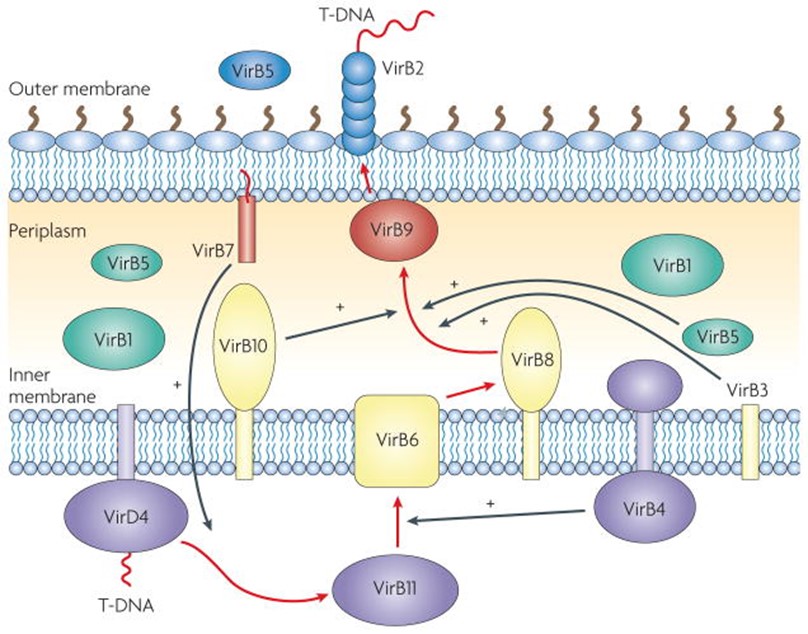Introduction to Secretion Systems in Microorganisms:
Microorganisms use a variety of secretion systems, including the type IV secretion system (T4SS), to move macromolecules like proteins and DNA over the cell membrane.
Both Gram-positive and Gram-negative bacteria, as well as certain archaea, have this incredibly adaptable class of secretion systems. It plays a crucial role in transporting a wide range of substrates, including single-protein units, complex toxins composed of multiple subunits, and nucleoprotein assemblies, highlighting its broad adaptability and functional significance.
They typically have 12 parts that are arranged into complexes that span two membranes and are driven by ATP. T4SSs have the ability to cross another host cell membrane, which enables substrates to be transferred straight into the recipient cell’s cytoplasm.
Overview of Type IV Secretion System (T4SS):
T4SSs can perform a number of tasks, such as conjugative DNA transfer, DNA absorption and release, and direct translocation of effector proteins or DNA/protein complexes into recipient cells, due to their ability to transfer both DNA and proteins. Even if their substrates and roles vary, all T4SSs share common components and operate similarly, indicating their evolutionary relatedness. Direct contact between cells facilitates the transfer of DNA by the first type of Type IV Secretion System (T4SS). This system is found in a wide range of organisms, including numerous Gram-positive and Gram-negative bacteria, as well as certain archaea. This process, known as conjugation, significantly boosts genomic flexibility and aids in microorganisms’ ability to adjust to environmental changes. The primary process by which antibiotic-resistant genes proliferate among harmful bacteria is conjugation.
Agrobacterium tumefaciens and the T-DNA Transfer System:
Agrobacterium tumefaciens, a well-studied species that specializes in introducing carcinogenic nucleoprotein complexes into plant cells, is another T4SS that transfers DNA. The second variant of the Type IV Secretion System (T4SS) enables the bidirectional movement of DNA, allowing cells to both absorb DNA from their surroundings and secrete it into the external environment. Two well-studied examples include the ComB system in Helicobacter pylori, which imports DNA from outside the cell, and the gonococcal genetic island (GGI) in Neisseria gonorrhoeae, which exports DNA into the extracellular space.
Proteins are transferred by a third kind of T4SS. The majority of T4SSs in that group are present in pathogenic bacteria, where they contribute significantly to virulence by forming pathogen-host interactions and/or delivering harmful effector proteins or protein complexes into the host cell’s cytoplasm.
Pathogenic Roles of T4SS in Bacteria:
T4SSs are crucial to the pathophysiology of many different types of bacteria.
- Neisseria gonorrhoeae, which mediates DNA uptake (which encourages virulence gene acquisition) using its T4SS, is a notable example of a bacterial pathogen that exploits T4SSs for virulence
- Legionella pneumophila, Brucella suis, and Helicobacter pylori, which use their T4SSs to translocate effector proteins into host cells during infection to disrupt their defense strategies.
- The intracellular pathogen L. pneumophila translocates over 200 effector proteins into the host cell using T4SS, where they are crucial in reshaping the architecture of the host cell to produce a vacuole that is conducive to bacterial proliferation.
- One notable example is Agrobacterium tumefaciens, which transports a portion of the Ti plasmid DNA covalently coupled to the relaxase VirD2 using a DNA processing mechanism similar to the conjugation systems.
- Agrobacterium tumefaciens causes crown gall disease in plants. Galls, or tumors, that develop on the roots, stems, or branches of different plant species are the hallmark of this illness. These galls occur when the bacterium enters plants through wounds and inserts a piece of its DNA into the plant’s genome, causing unchecked cell growth.
- In A. tumefaciens, a number of the T4SS components engage in successive interactions with the DNA substrate.
Most of the proteins (VirB6–VirB10, and maybe VirB3) constitute a scaffold of the substrate translocation channel that runs throughout the cell membrane.
VirB/VirD Protein Complex: Structure and Function:
- Core Complex Formation: VirB7, VirB9, and VirB10 assemble into a core complex that spans the entire bacterial envelope.
- Inner Membrane Channel Assembly: VirB6 and VirB8 hook onto the core complex’s inner membrane side. The translocation channel is subsequently completed by the recruitment of the ATPase module (VirB4, VirB11, and VirD4).
- The Pilus Assembly: VirB2 and VirB5 are enlisted to help create the distal secretion channel or the extracellular T-pilus. To enable pilus extrusion, VirB1 breaks down the peptidoglycan in the cell wall.
- Substrate Transfer Pathway: VirD4 binds T-DNA initially, then VirB11 transfers the substrate to VirB6–VirB8 in the inner membrane. All three ATPases (VirB4, VirB11, and VirD4) must hydrolyze ATP in order to facilitate this transfer.
The substrate moves through the VirB6–VirB8–VirB10 channel. The substrate is transferred to the outer membrane complex in the periplasm, where it is mediated by VirB2 and VirB9 with help from VirB3, VirB5, and VirB10.VirB10 plays a regulatory role by sensing ATPase activity and triggering conformational changes that may open the outer membrane channel. The substrate may traverse the periplasm through a pilus-like conduit made of VirB2 pilin, assembled within the core complex chamber.

Fig: T-DNA translocation pathway within the type IV secretion apparatus of Agrobacterium tumefaciens
Source: Fronzes, R., Christie, P. J., & Waksman, G. (2009). The structural biology of type IV secretion systems. Nature reviews. Microbiology, 7(10), 703–714. https://doi.org/10.1038/nrmicro2218
References:
- Fronzes, R., Christie, P. J., & Waksman, G. (2009). The structural biology of type IV secretion systems. Nature reviews. Microbiology, 7(10), 703–714. https://doi.org/10.1038/nrmicro2218
